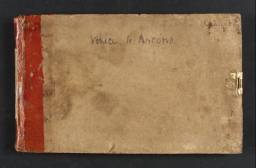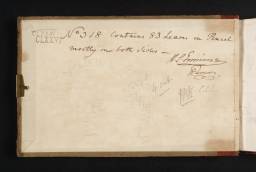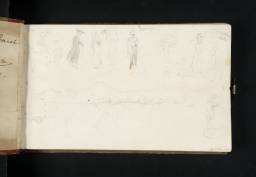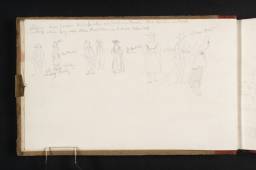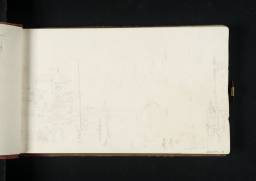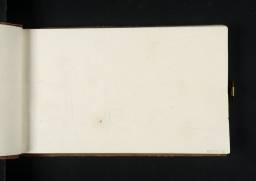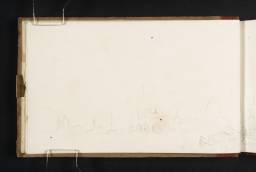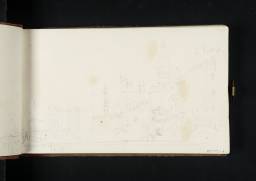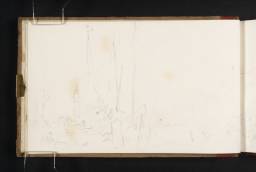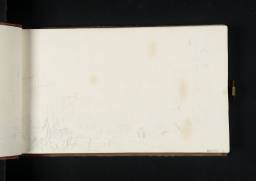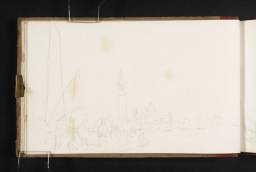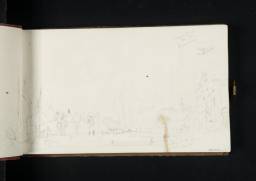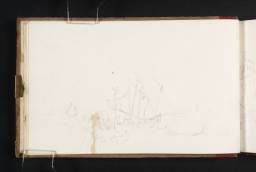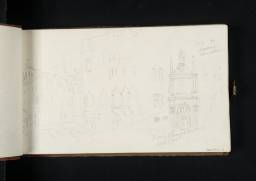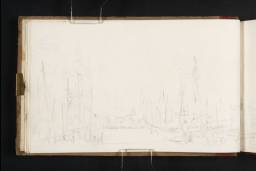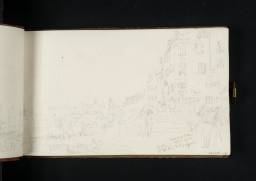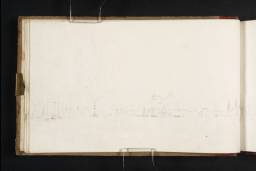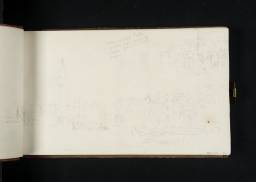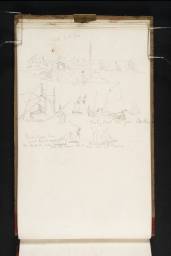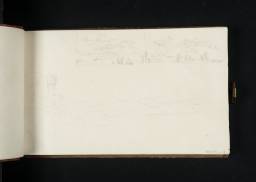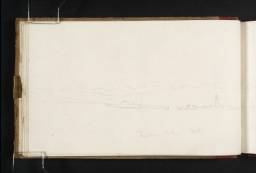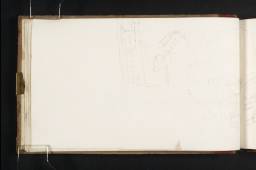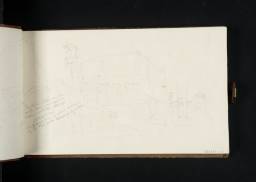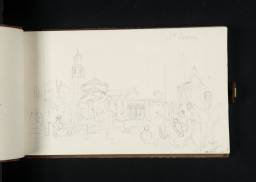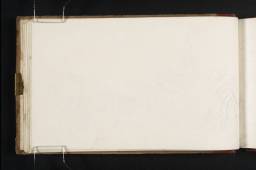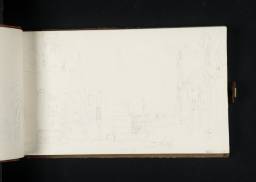Turner Bequest CLXXVI 1–86a
Sketchbook, bound in boards, covered in grey paper quarter-bound over brown leather spine; one brass clasp
90 leaves and pastedowns of white wove paper, page size 111 x 184 mm; partial watermark ‘Allnutt | 18’
Made by Thomas Smith and Henry Allnutt of Ivy Mill, Maidstone, Kent
Inscribed by Turner in ink ‘Venice to Ancona’ top centre of the front cover (D40894)
Inscribed by Turner in ink ‘[?9] Venice to Ancona’ on a label on the spine (D40893)
Inscribed by Turner in ink ‘4’ on the top edge of the page block
Numbered 318 as part of the Turner Schedule in 1854 and endorsed by the Executors of the Turner Bequest, inside front cover (D40895)
Blind-stamped with Turner Bequest monogram top left and inscribed in pencil and stamped in black ‘CLXXVI’ top right of front cover (D40894)
90 leaves and pastedowns of white wove paper, page size 111 x 184 mm; partial watermark ‘Allnutt | 18’
Made by Thomas Smith and Henry Allnutt of Ivy Mill, Maidstone, Kent
Inscribed by Turner in ink ‘Venice to Ancona’ top centre of the front cover (D40894)
Inscribed by Turner in ink ‘[?9] Venice to Ancona’ on a label on the spine (D40893)
Inscribed by Turner in ink ‘4’ on the top edge of the page block
Numbered 318 as part of the Turner Schedule in 1854 and endorsed by the Executors of the Turner Bequest, inside front cover (D40895)
Blind-stamped with Turner Bequest monogram top left and inscribed in pencil and stamped in black ‘CLXXVI’ top right of front cover (D40894)
Accepted by the nation as part of the Turner Bequest 1856
Exhibition history
References
The first quarter or so of this sketchbook (folios 2 recto–21 recto; D14491–D14527) comprises topographical views of Venice, presumably made towards the end of Turner’s brief first stay in the city in September 1819 during his first Italian tour. They complement the drawings made there in the latter two thirds of the similar Milan to Venice sketchbook (Tate; Turner Bequest CLXXV), under which Turner’s Venice work is discussed in general terms.1 Afterwards, he filled the rest of the present book as he travelled south-west to Bologna, and then south-east to Ancona on the Adriatic coast, before turning inland again, ultimately headed for Rome.2
In Venice, Turner began using this book in the Piazza San Marco (St Mark’s Square) on folio 2 recto (D14491), moved out through the Piazzetta to the Molo (folio 3 recto; D14492) and walked eastwards along the quays of the Riva degli Schiavoni, making a number of mostly double-page views looking back along the waterfront, west across the north side of the Bacino to the domes of Santa Maria della Salute, and south to the church on the Isola di San Giorgio Maggiore (folios 3 verso–10 recto; D14493–D14506). The detail in this sequence increases as he moved further from the entrance to the Piazzetta and adjacent buildings already carefully recorded in the other book.
Sunset studies and mountainous view of folio 11 recto (D14508) may have been made elsewhere, but the Venice subjects then continue in a somewhat haphazard sequence: folios 11 verso–12 recto (D14509–D14510) show the view north over the islands of the Lagoon towards the mainland, folios 12 verso–13 recto (D14511–D14512) the Rialto Bridge on the Grand Canal, folio 14 recto (D14513) the Tolentini church towards the north-west entrance of the canal, and folios 14 verso–15 recto (D14514–D14515) St Mark’s. Between folios 15 verso and 21 recto (D14516–D14527), numerous studies of varying size and detail apparently made in the course of a single excursion out on the waters of the Bacino and the Canale della Giudecca round off the foliated sequence of Venice, with an apocalyptic note of ‘all the steeples blood red’ on D14526. There are slight sketches of Venetian buildings inside the back cover (D40897), perhaps recollected later in the journey, while folio 52 recto (D14582; Turner Bequest CLXXVI 48) shows unidentified buildings and boats, perhaps at Venice or later on the journey.
Finberg felt that the ‘sketches in the second book differ somewhat in character from those in the first. They are less obviously made for the purpose of storing information, and are more directly concerned with ideas of future pictures. The difference, however, is slight; it is a matter of degree and of emphasis.’3 Luke Herrmann has considered what he characterised as Turner’s ‘much less detailed’ drawings here as ‘a sure sign that he was now confident that the essential features of the city were now stored in his powerful visual memory’,4 while James Hamilton has perceived ‘a precision and an expansiveness in the drawings in the two Venice sketchbooks that show Turner taking his time, and assuring himself that he would return again and again’.5 Hardy George has noted that the Venice sketchbook (Tate; Turner Bequest CCCXIV), used on Turner’s next visit in 1833 (Tate; Turner Bequest CCCXIV), ‘repeats most of the subjects’ drawn in 1819.6
Upon leaving Venice, likely on Monday 13 September,7 Turner travelled south-west towards Ferrara, sketched hastily inside the front cover (D40893), possibly recording a scene on the River Po in the vicinity (folio 10 verso; D14507); boats on the river are shown on folio 90 verso (D14652; Turner Bequest CLXXVI 86a). Perhaps still digesting his first experience of Venice, he made very few other drawings (folios 21 verso–23 recto; D14528–D14531) before arriving at Bologna,8 his next major stopping point, around a hundred miles on from Venice (see under folio 24 recto; D14532). Here he filled roughly another quarter of the book with studies in and around the city, before turning south-east towards the Adriatic coast, making drawings every few miles through a string of towns, small cities and intervening sites between folios 43 recto and 69 recto (D14566–D14613; Turner Bequest CLXXVI 39–65);9 each is listed here in terms of a single or key page:
?Imola (folio 37 verso; D14555; CLXXVI 33a); Faenza (47 recto; D14574; CLXXVI 43); Forlì (44 verso; D14569; CLXXVI 40a); Forlimpopolo (46 recto; D14572; CLXXVI 42); Cesena (46 verso; D14573; CLXXVI 42a); River Ronco (49 verso; D14579; CLXXVI 45a); Rimini (57 recto; D14592; CLXXVI 53a); San Marino (56 recto; D14590; CLXXVI 52); Gradara (61 recto; D14599; CLXXVI 57); Pesaro (61 verso; D14600; CLXXVI 57a); Fano (62 verso; D14602; CLXXVI 58a); Senigállia (67 verso; D14610; CLXXVI 63a); Rocca Priora (68 verso; D14612; CLXXVI 64a)
As he had at Ferrara, Turner paid notable attention to various massive rocca fortifications, as well as Roman monuments and everyday urban scenes, along this route. He concluded the sketchbook with an extensive survey of the port and city of Ancona (see under folio 99 verso; D14613; Turner Bequest CLXXVI 65a), about 140 miles from Bologna. This phase of the journey south would have been informed by condensed ink notes made from the 1815 edition of J.C. Eustace’s A Classical Tour through Italy in the contemporary Italian Guidebook sketchbook (Tate D13938; Turner Bequest CLXXII 4, transcribed and catalogued by Nicola Moorby); the passage beginning in Bologna is repeated here:
La Madonna di S Luca | 2 Towrs of brick Degli Asinella & dei Garisendi | Academy at Bologna and Science contains | wax models v curious Instituto & University | Public Fountain . [in pencil: ‘by J of Bol. good figure Ex legs’] | Imola. 20 Miles from B .. | To Faenza 10 M | Forli 9 Miles The tabernacle in the chapel of the sacrament | said to be M Angelo Benedictine Abbey of Mercuria | le | To Forlimpopoli 4 M Cesena 7 Mile. | on Castle and ancient Bridge of 3 arches | 2 Miles in the Pisatello or Rubicon. | St Marino | Savignano. 4 Miles Luso 6 M further. | Rimini bridge of the Ariminum marble | Gate and Arch of Agustus | Cattolica | 10 Miles. Pesaro Churches S Giovanni | La Misericordia S Carlo Bridge over | the Foglia | 7 miles to Farno a triumphal Arch to Ag | a gallery or arcade of 5 arches terribly [?defaced] | Bridge over the Metaurus. Monte Asdrubal | about 3 Miles from – Fossombrone on the Forli Road | Two hours Senegaglia | To Ancona 20 Miles. The Mole. port | triumphal arch to Trajan .. the Church of | Agostiniani. Giesu by (Vanvitelli)
For the Rubicon, see under folio 21 verso (D14528), and for Turner’s pencil note concerning Giambologna’s fountain at Bologna, perhaps added on the spot or soon afterwards, see under folio 27 recto (D14538; Turner Bequest CLXXVI 26d). Typically, there are a few incidental pages showing local figures and livestock; see under folio 1 recto (D14489). For studies of boats, see under folio 7 verso (D14501).
As quoted and cited individually, the entries here have been informed by extensive manuscript notes by Finberg and C.F. Bell in copies of Finberg’s Inventory held at Tate Britain, transcriptions of Bell’s notes elsewhere by Ian Warrell, and the latter’s own notes in Tate catalogue files.
See also Stainton 1985, pp.13, 14, Hamilton 2008, pp.42–3, 90 note 11, and Hamilton 2009, pp.40–1, 150 note 11.
For accounts of the route and subjects between Venice and Ancona, alsocited in individual entries, see Powell 1984, pp.78, 83, 93–4, 466–7 note 115, Powell 1987, pp.22, 24–6, Hamilton 2008, pp.43–4, and Hamilton 2009, p.42.
Finberg 1930, p.58, as part of a broader discussion, pp.58, 61; see also pp.19, 21, 22, 167, and Finberg 1961, p.261.
Warrell 2003, p.17; see Powell 1984, p.82, giving Turner’s departure as ‘12 or 13 September’, and p.462 note 61, citing documentation in Hardy George, ‘Turner in Venice’, unpublished Ph.D thesis, Courtauld Institute of Art, University of London 1970, p.65; see also Powell 1987, p.24; Hamilton 2009, p.150 note 9, notes other possibilities, discussed in the Introduction to the Milan to Venice sketchbook in the present catalogue.
Technical notes
The relevant text in Finberg’s Inventory is as follows:
[Page] 26. Do. do. [i.e. ditto: A town; probably Bologna.]
(The following four leaves were found loose, but appear to belong here.)
„ 26a. [bracketed with ‘26b’, immediately below, as one entry] Palazzo Publico, Bologna, with fountain of Neptune in foreground.
„ 26c. Bridge, with buildings on a hill.
„ 26d. Palazzo del Podestà, and other buildings.
„ 26e. Various figures, &c.
„ 26f. The Piazza del Nettuno ; also “Arcade to Madonna del ...” (probably Madonna di San Luca).
„ 26g. Buildings on an eminence.
„ 26h. View of Bologna, with the Torre Asinelli to the right.
---------------
„ 27. Church with Campanile. S. Francesco.22
[Page] 26. Do. do. [i.e. ditto: A town; probably Bologna.]
(The following four leaves were found loose, but appear to belong here.)
„ 26a. [bracketed with ‘26b’, immediately below, as one entry] Palazzo Publico, Bologna, with fountain of Neptune in foreground.
„ 26c. Bridge, with buildings on a hill.
„ 26d. Palazzo del Podestà, and other buildings.
„ 26e. Various figures, &c.
„ 26f. The Piazza del Nettuno ; also “Arcade to Madonna del ...” (probably Madonna di San Luca).
„ 26g. Buildings on an eminence.
„ 26h. View of Bologna, with the Torre Asinelli to the right.
---------------
„ 27. Church with Campanile. S. Francesco.22
In the foliation of an undisturbed sketchbook, Finberg’s ‘a’ suffix generally indicates a verso, but the placing of the note between ‘26’ and ‘26a’ would seem to imply the latter as a face of one of the separated leaves in this case. However, the comment may have been placed at that point in the text in order to bracket it with ‘26b’ as a single subject, the usual convention for a double-page drawing. In the sequence below, reflecting the physical inscriptions and stamps on the pages as noted in individual entries and the longstanding linkage of Turner Bequest numbers with Tate ‘D’ accession numbers, the verso of folio 26, which had apparently remained in the book, has become ‘26b’, while 28 recto is ‘26a’. If confusion had not arisen and Finberg’s order interpreted as suggested below, what are now folios 27 and 28 would have been transposed, resolving the alphabetical sequence of suffixes.
On the other hand, the slight, rather loose continuations of architectural details on folios 26 verso and 27 verso as now bound do seem to be more likely to match up with the full-page views on folios 27 recto and 28 recto respectively than if those leaves were transposed as Finberg seems to imply. The issue is not a major one, but typical of the occasional awkward discrepancies arising from the restoration of sketchbook pages which had been extracted for display in the nineteenth century. In this instance there is no record of such an event, and the presence of a note apparently made at the earliest stages of National Gallery ownership may imply that the pages had already been detached for some reason, possibly by the artist himself.
| Folio | Tate | Turner Bequest |
| 26 Recto | D14534 | CLXXVI 26 |
| 26 Verso | D14536 | CLXXVI 26b (?Finberg 1909 as ‘26a’) |
| 27 Recto | D14538 | CLXXVI 26d |
| 27 Verso | D14539 | CLXXVI 26e |
| 28 Recto | D14535 | CLXXVI 26a (?Finberg 1909 as ‘26b’) |
| 28 Verso | D14537 | CLXXVI 26c |
| 29 Recto | D14540 | CLXXVI 26f |
| 29 Verso | D14541 | CLXXVI 26g |
| 30 Recto | D14542 | CLXXVI 26h |
| 30 Verso | - | [blank] |
| 31 Recto | D14543 | CLXXVI 27 |
| 32 Recto | D14544 | CLXXVI 28 |
| 32 Verso | D14545 | CLXXVI 28a |
| 33 Recto | D14546 | CLXXVI 29 |
| 33 Verso | D14547 | CLXXVI 29a |
| 34 Recto | D14548 | CLXXVI 30 |
| 34 Verso | D14549 | CLXXVI 30a |
| 35 Recto | D14550 | CLXXVI 31 |
| 35 Verso | D14551 | CLXXVI 31a |
| 36 Recto | D14552 | CLXXVI 32 |
| 36 Verso | D14553 | CLXXVI 32a |
| 37 Recto | D14554 | CLXXVI 33 |
| 37 Verso | D14555 | CLXXVI 33a |
| 38 Recto | D14556 | CLXXVI 34 |
| 38 Verso | D14557 | CLXXVI 34a |
| 39 Recto | D14558 | CLXXVI 35 |
| 39 Verso | D14559 | CLXXVI 35a |
| 40 Recto | D14560 | CLXXVI 36 |
| 40 Verso | D14561 | CLXXVI 36a |
| 41 Recto | D14562 | CLXXVI 37 |
| 41 Verso | D14563 | CLXXVI 37a |
| 42 Recto | D14564 | CLXXVI 38 |
| 42 Verso | D14565 | CLXXVI 38a |
| 43 Recto | D14566 | CLXXVI 39 |
| 43 Verso | D14567 | CLXXVI 39a |
| 44 Recto | D14568 | CLXXVI 40 |
| 44 Verso | D14569 | CLXXVI 40a |
| 45 Recto | D14570 | CLXXVI 41 |
| 45 Verso | D14571 | CLXXVI 41a |
| 46 Recto | D14572 | CLXXVI 42 |
| 46 Verso | D14573 | CLXXVI 42a |
| 47 Recto | D14574 | CLXXVI 43 |
| 47 Verso | D14575 | CLXXVI 43a |
| 48 Recto | D14576 | CLXXVI 44 |
| 48 Verso | D14577 | CLXXVI 44a |
| 49 Recto | D14578 | CLXXVI 45 |
| 49 Verso | D14579 | CLXXVI 45a |
| 50 Recto | D14580 | CLXXVI 46 |
| 51 Recto | D14581 | CLXXVI 47 |
| 52 Recto | D14582 | CLXXVI 48 |
| 52 Verso | D14583 | CLXXVI 48a |
| 53 Recto | D14584 | CLXXVI 49 |
| 53 Verso | D14585 | CLXXVI 49a |
| 54 Recto | D14586 | CLXXVI 50 |
| 54 Verso | D14587 | CLXXVI 50a |
| 55 Recto | D14588 | CLXXVI 51 |
| 55 Verso | D14589 | CLXXVI 51a |
| 56 Recto | D14590 | CLXXVI 52 |
| 56 Verso | D14591 | CLXXVI 53 |
| 57 Recto | D14592 | CLXXVI 53a |
| 58 Recto | D14593 | CLXXVI 54 |
| 48 Verso | D14594 | CLXXVI 54a |
| 59 Recto | D14595 | CLXXVI 55 |
| 59 Verso | D14596 | CLXXVI 55a |
| 60 Recto | D14597 | CLXXVI 56 |
| 60 Verso | D14598 | CLXXVI 56a |
| 61 Recto | D14599 | CLXXVI 57 |
| 61 Verso | D14600 | CLXXVI 57a |
| 62 Recto | D14601 | CLXXVI 58 |
| 62 Verso | D14602 | CLXXVI 58a |
| 63 Recto | D14603 | CLXXVI 59 |
| 63 Verso | D14604 | CLXXVI 59a |
| 64 Recto | D14605 | CLXXVI 60 |
| 65 Recto | D14606 | CLXXVI 61 |
| 65 Verso | D14607 | CLXXVI 61 v |
| 66 Recto | D14608 | CLXXVI 62 |
| 67 Recto | D14609 | CLXXVI 63 |
| 67 Verso | D14610 | CLXXVI 63a |
| 68 Recto | D14611 | CLXXVI 64 |
| 68 Verso | D14612 | CLXXVI 64a |
| 69 Recto | D14613 | CLXXVI 65 |
| 69 Verso | D14614 | CLXXVI 65a |
| 70 Recto | D14615 | CLXXVI 66 |
| 70 Verso | D14616 | CLXXVI 66a |
| 71 Recto | D14617 | CLXXVI 67 |
| 71 Verso | D14618 | CLXXVI 67a |
| 72 Recto | D14619 | CLXXVI 68 |
| 72 Verso | D14620 | CLXXVI 68a |
| 73 Recto | D14621 | CLXXVI 69 |
| 73 Verso | D14622 | CLXXVI 69a |
| 74 Recto | D14623 | CLXXVI 70 |
| 74 Verso | D14624 | CLXXVI 70a |
| 75 Recto | D14625 | CLXXVI 71 |
| 75 Verso | D14626 | CLXXVI 71a |
| 76 Recto | D14627 | CLXXVI 72 |
| 76 Verso | D14628 | CLXXVI 72a |
| 77 Recto | D14629 | CLXXVI 73 |
| 77 Verso | D14630 | CLXXVI 73a |
| 78 Recto | D14631 | CLXXVI 74 |
| 78 Verso | D14632 | CLXXVI 74a |
| 79 Recto | D14633 | CLXXVI 75 |
| 79 Verso | D14634 | CLXXVI 75a |
| 80 Recto | D14635 | CLXXVI 76 |
| 80 Verso | D14636 | CLXXVI 76a |
| 81 Recto | D14637 | CLXXVI 77 |
| 81 Verso | D14638 | CLXXVI 77a |
| 82 Recto | D14639 | CLXXVI 78 |
| 82 Verso | D14640 | CLXXVI 78a |
| 83 Recto | D14641 | CLXXVI 79 |
| 83 Verso | D14642 | CLXXVI 79a |
| 84 Recto | D14643 | CLXXVI 80 |
| 84 Verso | D14644 | CLXXVI 80a |
| 85 Recto | D14645 | CLXXVI 81 |
| 85 Verso | D14646 | CLXXVI 81a |
| 86 Recto | D14647 | CLXXVI 82 |
| 87 Recto | D14648 | CLXXVI 83 |
| 88 Recto | D14649 | CLXXVI 84 |
| 89 Recto | D14650 | CLXXVI 85 |
| 90 Recto | D14651 | CLXXVI 86 |
| 90 Recto | D14652 | CLXXVI 86a |
| Inside Back Cover | D40897 | - |
How to cite
Matthew Imms, ‘Venice to Ancona Sketchbook 1819’, sketchbook, March 2017, in David Blayney Brown (ed.), J.M.W. Turner: Sketchbooks, Drawings and Watercolours, Tate Research Publication, July 2017, https://www

